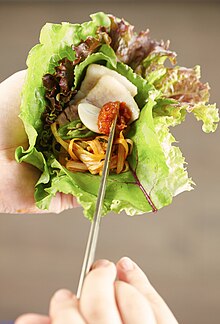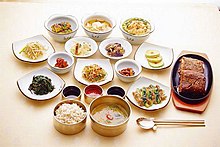| Ssam | |
 A ssam consisting of meat, various banchan, and ssamjang A ssam consisting of meat, various banchan, and ssamjang | |
| Korean name | |
|---|---|
| Hangul | 쌈 |
| Revised Romanization | ssam |
| McCune–Reischauer | ssam |
| This article is part of a series on |
| Korean cuisine 한국 요리 조선 료리 |
|---|
 |
| Staples |
|
AncillariesPickled dishes
Soups & stews |
| DessertsHangwa |
DrinksList of Korean drinks
|
| Condiments |
| Utensils |
| Other |
Ssam (Korean: 쌈; lit. wrapped) are dishes in Korean cuisine where one food is wrapped in another. A common variety is meat such as pork wrapped in a leafy vegetable. It is often accompanied by the condiment ssamjang and can also be topped with raw or cooked garlic, onion, green pepper, or a banchan (small side dish) such as kimchi. Ssam is usually bite-sized to prevent spilling of the fillings.
History
Under the Buddhist influence that was especially strong during the Kingdom of Goryeo, killing and eating an animal was highly discouraged. This has led to numerous Korean vegetable dishes, especially ssam, to be created and emerge as a prominent dish during the era. After its emergence, the dish was mentioned numerous times in ancient Korean records.
The ancient Korean book of customs Dongguksesigi noted that the women of Goryeo who were taken as servants by the Yuan dynasty made and ate ssam to have the taste of their home country's food and soothe homesickness. The same book also noted that ssam had become an established seasonal dish by the Joseon era, which was especially eaten as a festive dish during the day of Daeboreum. The ssam eaten during Daeboreum was believed to bring a good fortune and called bokssam (복쌈), which meant "fortune ssam".
Ssam was mentioned by the many texts in the Joseon era. One of them is Eou yadam, a collection of stories written by the scholar Yu Mong-In, who recounts wrapping a sardine in a leafy vegetable with rice and ssamjang. In Sasojeol (사소절,士小節), a Joseon etiquette book, Lee deok-mu said it is a manner to scoop and roll a ball of rice first before wrapping it with a vegetable from atop while eating ssam. He also told readers to wrap a ssam in a bitable size as it looked rude to puff the one's cheeks while eating. Jeong yak-yong, a Joseon intellectual, described in his poem about putting gochujang, the traditional Korean red chili paste, and the root of green onion on a lettuce along with rice to eat a ssam.
Ssam from Goryeo was also recognized in the poem by Yang Yunfu of Yuan dynasty. In his poem, Yang noted how the people of Goryeo eat rice by wrapping it with raw vegetables and complimented the pleasant scent of Goryeo's lettuce.
In modern days, ssam is slowly gaining popularity outside of Korea and is being served at restaurants in various locations such as New York City, Tokyo and Brisbane.
Variations
Various vegetables are used as ingredients such as lettuce, cabbage, bean leaves, and pumpkin leaves, which are used either raw or blanched. Seaweed such as miyeok (미역) (sea mustard seaweed) and gim (dried laver) are also used. Ssam can be used to refer to dishes using beef tongue, roe, pork, clams, or sea cucumbers wrapped and cooked in eggs. Depending on one's taste, ssam can contain side dishes such as kimchi (김치) and garlic, and sauce such as ssamjang (쌈장), doenjang (된장), red pepper paste (고추장), and oil sauce. Sashimi and gwamegi (과메기) are also eaten with wraps.
By ingredients
- Bossam: with steamed pork, e.g. shoulder and is a popular dish throughout Korea.
- Ssambap is a dish in which rice is included.
By wrap type
Specific types:
- Baechu ssam (배추쌈), wrapped with napa cabbage leaf
- Chwi ssam (취쌈), wrapped with chwinamul
- Eossam (어쌈), wrapped with thin fish filet
- Gimssam (김쌈), wrapped with gim, seaweed
- Gotgam ssam (곶감쌈), wrapped with dried persimmon
- Hobakip ssam (호박잎쌈), wrapped with pumpkin leaf
- Jeonbok ssam (전복쌈), wrapped with sliced and soaked dried abalone
- Kimchi ssam (김치쌈), wrapped with kimchi
- Kkaenip ssam (깻잎쌈), wrapped with perilla leaf
- Milssam (밀쌈), wrapped with a thin crepe made from wheat flour
- Muneo ssam (문어쌈), wrapped with sliced octopus
- Po'ssam (포쌈), wrapped with seasoned raw beef
- Sangchu ssam (상추쌈), wrapped with lettuce
Gallery
-
 Making ssam
Making ssam
-
 Ssam vegetables and ssamjang
Ssam vegetables and ssamjang
-
 Leaves used for wrapping in ssam dishes
Leaves used for wrapping in ssam dishes
-
 Bossam dish from Gwangju
Bossam dish from Gwangju
-
 Milssam, wrap with thin pancakes
Milssam, wrap with thin pancakes
-
 Roseupyeonchae (로스편채), vegetables wrapped in roasted beef slices
Roseupyeonchae (로스편채), vegetables wrapped in roasted beef slices
See also
References
- ^ 쌈 (Ssam) Archived 2011-06-10 at the Wayback Machine Encyclopedia of Korean Culture (in Korean)
- "Customs". Korea Tourism Organization. Archived from the original on 2012-01-20. Retrieved 2013-04-05.
- "How Make Ssam Bap (Korean Lettuce Wraps)". About.com. Archived from the original on 2010-04-12. Retrieved 2013-04-15.
- ^ Jeong, H. J. (2012). "A Review on the Korean Temple Foods within the scope of cultural tourism contents" (PDF). Review of Korea Contents Association. 10 (3). The Korea Contents Association. Archived (PDF) from the original on 2021-07-09. Retrieved 2021-07-06.
- ^ "Ssam". Encyclopedia of Korean Culture. Archived from the original on 2023-09-18. Retrieved 2021-07-06.
- ^ "Ssam". National Folk Museum of Korea. Archived from the original on 2021-04-17. Retrieved 2021-04-17.
- "Sangchu ssam". Encyclopedia of Korean Culture. Archived from the original on 2020-11-11. Retrieved 2021-07-06.
- (in Korean) Restaurant opens in Sapporo Archived 2013-10-29 at the Wayback Machine, Financial News, 2006-06-16. Retrieved 2010-06-23
- Momofuku Ssam Archived 2010-06-27 at the Wayback Machine, Columbia Daily Tribune, 2010-06-23
- "Ssam". The National Folk Museum of Korea. Archived from the original on 2021-04-17. Retrieved 2021-04-17.
- "Bossam's continuous popularity" Archived 2016-03-03 at the Wayback Machine Money & Business. 12 May 2010. Retrieved 2010-06-23 (in Korean)
- Jung, Alex "5 Korean ways to eat a pig" Archived 2011-11-13 at the Wayback Machine CNN Go. 11 November 2011. Retrieved 2012-04-11
- (in Korean) "Korean dictionary:Ssambap" Archived 2023-09-18 at the Wayback Machine National Institute of the Korean Language (in Korean)
- "쌈 (Ssam)" (in Korean). Doosan Encyclopedia. Archived from the original on 2015-09-23. Retrieved 2013-04-15.
- 김쌈 (in Korean). Naver Dictionary. Archived from the original on 2023-09-18. Retrieved 2013-04-05.
- 호박잎쌈 (in Korean). Naver Dictionary. Archived from the original on 2015-02-23. Retrieved 2013-04-05.
- 깻잎쌈 (in Korean). Naver Dictionary. Archived from the original on 2023-09-18. Retrieved 2013-04-05.